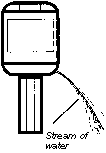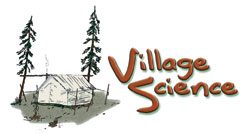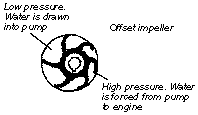An Outboard Cooling System
|
 As
gasoline is burned in an outboard motor, the temperature quickly rises
in and around the piston and cylinder. The chemical energy of the
fuel is changed to the energy of motion of the piston, as well as
heat and sound energy. If the heat were not carried away, it would
soon warp and melt engine parts. The engine may run again, and seem
all right for a while, but the damage is never reversed. Engines don’t
heal like people, plants, and animals. As
gasoline is burned in an outboard motor, the temperature quickly rises
in and around the piston and cylinder. The chemical energy of the
fuel is changed to the energy of motion of the piston, as well as
heat and sound energy. If the heat were not carried away, it would
soon warp and melt engine parts. The engine may run again, and seem
all right for a while, but the damage is never reversed. Engines don’t
heal like people, plants, and animals.
Airplanes, chainsaws, and most snowmachines rely on air flow to carry the heat away. Outboard motors can efficiently use water for cooling. Water is has greater mass and is a better conductor of heat than air. Automobiles, trucks, and high-tech snowmachines are also water-cooled. The water comes into the outboard’s engine through the lower unit, which is below water level as the boat is moving. Without a pump of some kind, water couldn’t flow up to the engine. The water pump is the heart of the cooling system. |
||
Main Parts
Operation If the impeller were exactly in the center of the housing, it would turn with the drive shaft, spinning water within the housing, but it would not pump water. However, it is designed with an offset impeller. When the impeller turns, it has a lot of room on one side of the pump, and not much room on the other. As the drive shaft and impeller spin, water enters on the side that has a lot of room, and is pressured out on the side that doesn’t have much room. ScreenA screen protects the opening to the water pump on the lower unit. It keeps grass, sticks, and small stones from plugging the cooling system, and destroying the engine. |
|||
ThermostatWhen an engine is cold, it doesn’t run well at all. Ignition requires three things: fuel, oxygen, and heat. If any of these is lacking, combustion will not occur efficiently. The thermostat prevents the cooling water from getting to the cylinder walls until there is enough heat for efficient combustion. Once the cylinder temperature is up, the thermostat allows the cooling water to flow from the water pump through the water jacket and out the exhaust. If a small stone gets jammed in the thermostat, it can be stuck closed which causes the engine to overheat, or it can be stuck open, making warmup very difficult. If a motor overheats from cooling system failure, quickly remove the spark plugs and pour oil into the cylinder to keep the piston rings from ceasing up in the cylinder. Gently pull the starter rope to keep parts moving. |
|||
 |
IndicatorOn the side of most motors there is a small hole that emits a stream of water. This is only an indicator that the water pump is working. Most of the water that comes from the cylinders is exhausted through the lower unit. During cold weather, the indicator might freeze even though the pump is working well. |
||
Considerations When the motor is stopped and left in an upright position, silt in the water settles to the bottom of the water pump. When the engine is started again the impeller is severely worn by the silt. To prevent this, good pilots tilt their motor up after stopping. This drains the water pump. A good pilot doesn’t do this when the temperatures are freezing. The motor is left down with the pump below the water line to keep it from freezing and cracking. Fortunately the silty rivers become clear once freezing temperatures cause the water level to drop. The hazard of silt in the pump no longer exists. It is important, however, to pull the starter rope very slowly before starting the engine in cold weather. To pull on the starter rope quickly when the water pump is frozen could strip the connection between the impeller and the driveshaft, ruining the impeller and stranding the pilot. When a water pump freezes, pour hot water on the lower unit housing until it is thawed. Usually one teapot of boiling water is enough to free it. Some people pour a little gas in a coffee can, throw in a match, and hold the burning gasoline under the lower unit with pliers. Gasoline is very dangerous and this method is not recommended. Inexperienced pilots often hit bottom, running their motors in the mud trying to get to deeper water. Even if there isn’t gravel to damage the prop, the water pump draws tremendous amounts of silt, wearing the impeller and housing. |
|||
Common Problems
An oldtimer made a scoop from a metal can and bolted it in place of the intake screen on the lower unit. He removed the worn impeller in the pump. Forward motion of the boat forced water into the scoop up through the upper unit. As long as he ran full throttle in forward he had enough water to cool the engine. It was a good temporary solution. An extra impeller and housing are not too expensive to have as spare parts in a tool box as they are so important to an engine’s operation. |
|||
 |
Activities
|
||
 |
Student Response
|
||
 |
Math
|

 There
are three main parts to the pump:
There
are three main parts to the pump:
 While
this seems very simple, it is the basis upon which many other kinds
of pumps work, particularly fuel pumps.
While
this seems very simple, it is the basis upon which many other kinds
of pumps work, particularly fuel pumps.
 Many
of Alaska’s rivers are silty. Friction with the silty water
wears the impeller and housing much quicker than clear water. Some
water pump housings are lined with very durable chromium steel.
Others are made of soft aluminum. Aluminum wears quickly and the
jagged pieces of the worn housing cut the impeller to pieces.
Many
of Alaska’s rivers are silty. Friction with the silty water
wears the impeller and housing much quicker than clear water. Some
water pump housings are lined with very durable chromium steel.
Others are made of soft aluminum. Aluminum wears quickly and the
jagged pieces of the worn housing cut the impeller to pieces.
 The
most common problems with water pumps are:
The
most common problems with water pumps are:
 Some
people bail water on their engines to cool them until they get home.
This cools the outer jacket of the engine, but doesn’t cool
the cylinder walls well at all. The operator might get home, but
not without internal damage to the engine.
Some
people bail water on their engines to cool them until they get home.
This cools the outer jacket of the engine, but doesn’t cool
the cylinder walls well at all. The operator might get home, but
not without internal damage to the engine.